The Setting Sun - Gotterdammerung, Japan 1944.
- Thread starter unmerged(59906)
- Start date
-
We have updated our Community Code of Conduct. Please read through the new rules for the forum that are an integral part of Paradox Interactive’s User Agreement.
You are using an out of date browser. It may not display this or other websites correctly.
You should upgrade or use an alternative browser.
You should upgrade or use an alternative browser.
Ha, youre stupid American, (although cool) Delorean will fall beneath the time machine, *remble disappears and then reappears in my history bok as Chief of Staff of German*
I'm German myself.  *whispers* But I am secretly working for the Brits.
*whispers* But I am secretly working for the Brits.
If anything Remble will be Chief of the Imperial Staff in London.
If anything Remble will be Chief of the Imperial Staff in London.
The only country he hasn't saved yet is Italy.
And all the other Axis minors. :wacko:
Nice update Remble, although I too am wondering of the whereabouts of the Super BB's. If they arn't going to be used try to sell them off for divisions or materials..
And all the other Axis minors. :wacko:
Nice update Remble, although I too am wondering of the whereabouts of the Super BB's. If they arn't going to be used try to sell them off for divisions or materials..
Sokraates - Thank you. The super powers like Nepal have to be removed before you can tackle the more minor enemy Nations like the U.S.A. 
Thurak - Thank you. I have made some mistakes just nothing large enough to mention so far. Mostly some timing errors on my part. The enemy squadrons would not prevent an air strike on Rangoon just a Carrier strike, but as you can see Yamamoto can handle the remains of that fleet easily enough.
String Theory, Maj. von Mauser - The Brazilians are there for entertainment value I think, they don't really present any kind of threat. With my lack of IC to repair anything right now the SHBB's are stuck on 93 and 71% but will be high priority once I can repair more effectively. I don't really need them for the moment but it is always nice to have that extra fleet at sea.
stnylan - They are being sunk slowly, and I am fairly sure they won't be replacing a Battleship any time soon.
Deus - I like sea battles so I do try and keep them around, just not the really large ones for the time being. There will come a time when the IJN goes on the offensive but its going to be at least 3 months as I need to repair a lot of it.
Lord Strange, trekaddict - I think you can safely say that this will be the last AAR I do on 1944. What else I could do I have no idea
Update to follow ...
Thurak - Thank you. I have made some mistakes just nothing large enough to mention so far. Mostly some timing errors on my part. The enemy squadrons would not prevent an air strike on Rangoon just a Carrier strike, but as you can see Yamamoto can handle the remains of that fleet easily enough.
String Theory, Maj. von Mauser - The Brazilians are there for entertainment value I think, they don't really present any kind of threat. With my lack of IC to repair anything right now the SHBB's are stuck on 93 and 71% but will be high priority once I can repair more effectively. I don't really need them for the moment but it is always nice to have that extra fleet at sea.
stnylan - They are being sunk slowly, and I am fairly sure they won't be replacing a Battleship any time soon.
Deus - I like sea battles so I do try and keep them around, just not the really large ones for the time being. There will come a time when the IJN goes on the offensive but its going to be at least 3 months as I need to repair a lot of it.
Lord Strange, trekaddict - I think you can safely say that this will be the last AAR I do on 1944. What else I could do I have no idea
Update to follow ...
Operation Dilemma
17
17
0000 March 10 1945.
BB Division1 Flagship. IJN Yamashiro, Gulf of Martapan.
Enemy fleets were being detected all over the Pacific, some of which were fairly large and potentially dangerous.
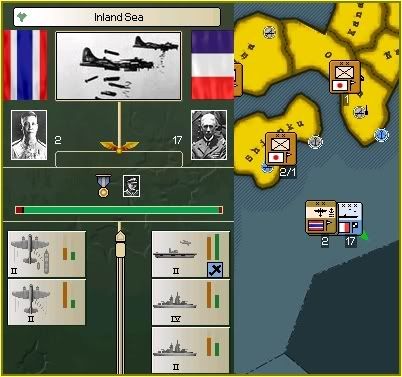
The French Carrier Fleet had moved north from Indonesia and was now off the coast of the Japanese mainland. Its course and speed indicated that it was heading towards the Mariana Trench.
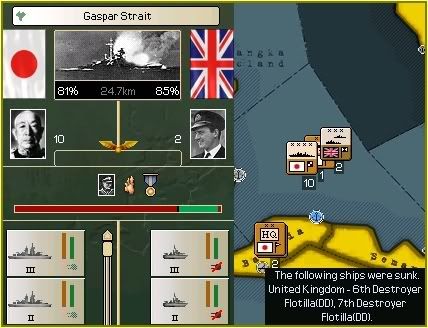
Koga had left Singapore with his medium sized Battlefleet in response to a sighting by naval patrol aircraft. The 6th and 7th Destroyer Flotillas were both sunk by the guns of IJN Nagato.
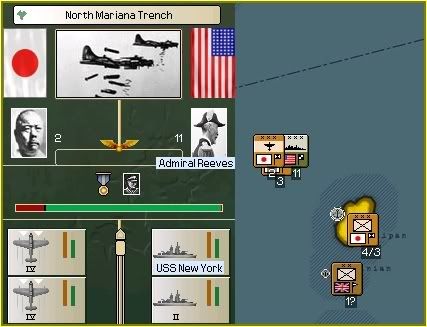
At 0000 hours on March 11th another American fleet was detected in the North Mariana Trench. Admiral Reeves had returned with his Battlefleet consisting mostly of older ship classes.
0700 March 11th 1945.
North China Army Headquarters. Jinghong, China.
The aerial bombardment of Allied forces in Burma was beginning to slowly reduce the number of enemy troops facing Higashikuni and his troops.
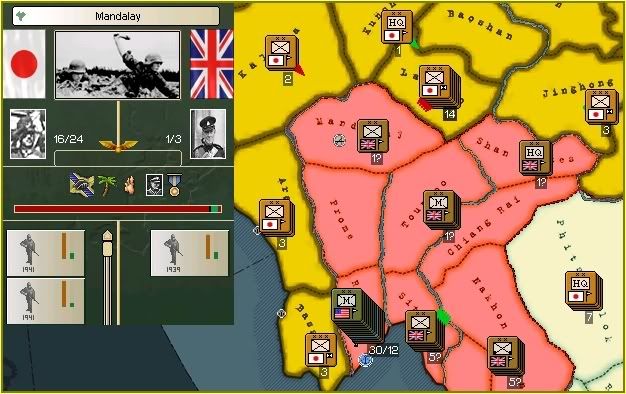
The British were still trying to protect Mandalay but one division was not going to halt progress, it just made it easier to destroy the enemy troops.
0000 March 12th 1945.
BB Division 1 Flagship. IJN Yamashiro, Gulf of Martapan.
Reports being received by Yamamoto onboard the IJN Yamashiro were predominantly from the Pacific for the time being and concentrated around the Mariana Trench. The increased naval activity in the region could mean another invasion attempt would be made by the Allies.
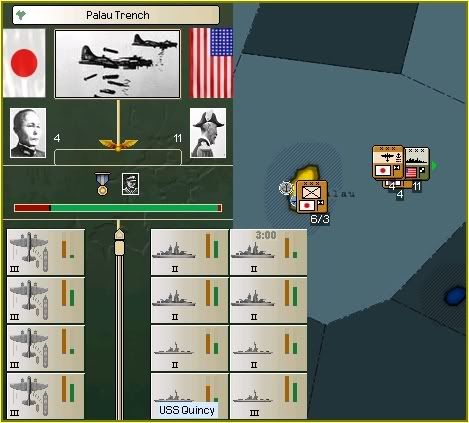
Ozawa was still patrolling the area and had found Admiral Reeves in the Palau Trench. He would not lose any of his Battleships on this occasion as the bombers concentrated their fire on the most modern ship in his fleet, the Heavy Cruiser USS Quincy. It would sink by 0300 hours and Reeves would leave the area before any more ships were sunk.
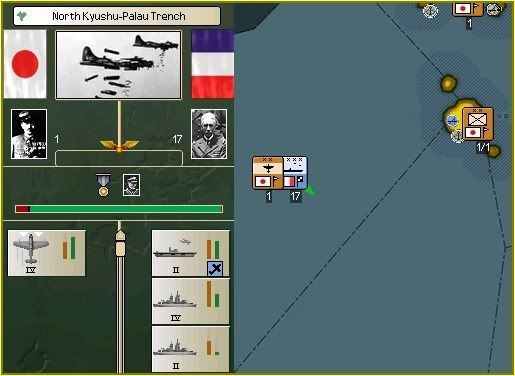
At 0600 hours the latest spotting reports confirmed that the French fleet was indeed heading towards the Mariana Trench where Ozawa would be waiting.

The need to continue operations without risking damaged ships forced Yamamoto to order Nagano to split his Carrier force in two and send the more damaged ships back to Japan for repairs. Admiral Godo was given command of this second Carrier fleet in recognition of his work running a Transport fleet during recent operations. Anti-Submarine patrols would be conducted around Japan as and when required by this damaged fleet.
0000 March 12th 1945.
Intelligence Offices. Tokyo, Japan.
Kuniaki had spent what financial reserves had been available wisely and built up his network of counter espionage agents in Japan as well as trying to infiltrate overseas.
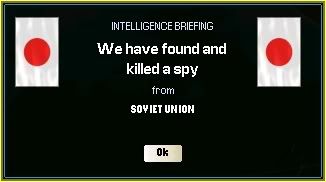
The first fruits of his labours was the capture of a Soviet spy on Japanese soil.
0000 March 12th 1945.
Diplomatic Offices. Tokyo, Japan.
Mamoru was entertaining the Ambassador from Venezuela in his offices. Relations between the two Countries had improved considerably over the last few months with constant trade passing between them.
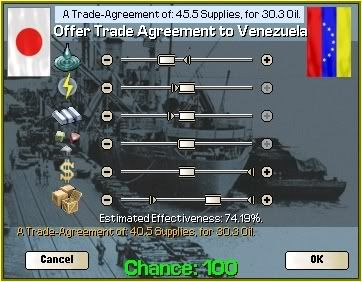
After several drinks Mamoru managed to pursuade the Ambassador to alter his trade agreement for oil, which would reduce the amount of supplies that Japan would exchange for the commodity.
1600 March 12th 1945.
BB Division 1 Flagship. IJN Yamashiro, Gulf of Martapan.
Enemy shipping in the Indian Ocean and the Bay of Bengal had reduced considerably over the last two months, largely as a result of massive losses to both the British and American merchant marine.
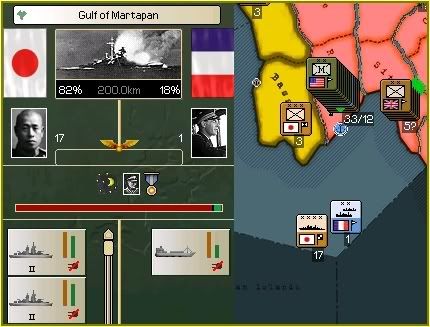
The French tried in vain to run the blockade of Rangoon and lost one of their Transport Flotillas in the process. No ship could claim the final killing blow.
2000 March 12th 1945.
North China Army Headquarters. Jinghong, China.
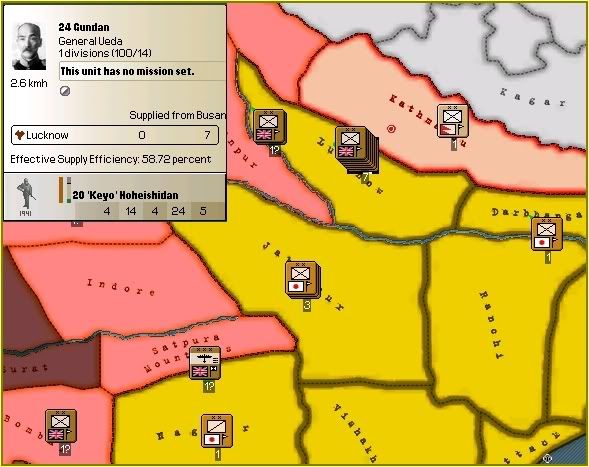
0100 March 13th 1945.
North Mariana Trench.
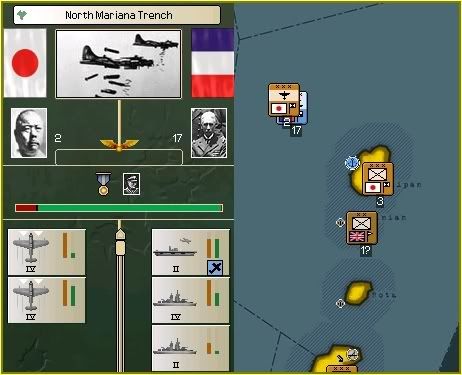
0700 March 13th 1945.
North China Army Headquarters. Jinghong, China.

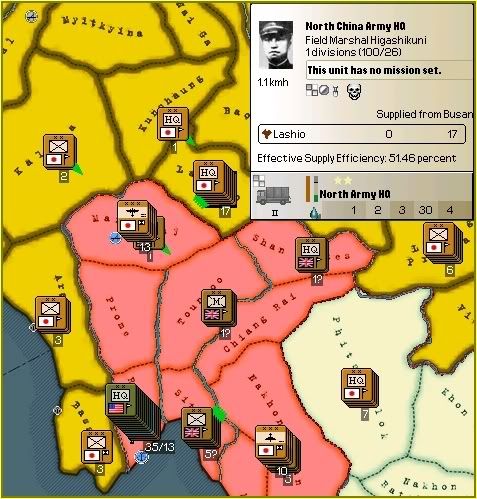
2300 March 14th 1945.
The Skies Above the Sape Strait.
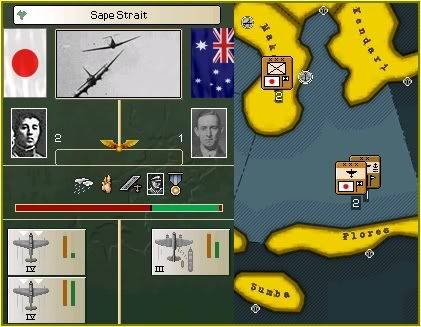
1200 March 15th 1945.
North China Army Headquarters. Lashio, Burma.
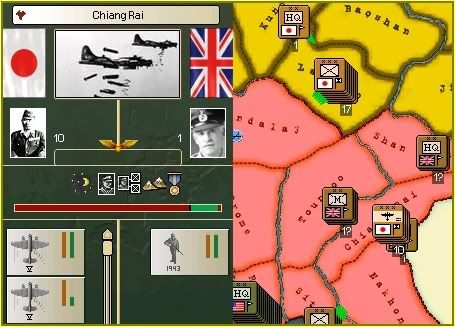

0500 March 16th 1945.
BB Division 1 Flagship. IJN Yamashiro, Gulf of Martapan.
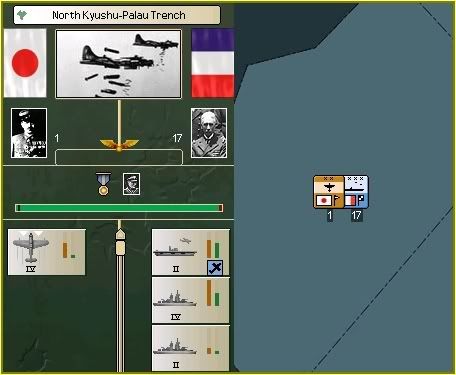
1400 March 16th 1945.
North China Army Headquarters. Lashio, Burma.
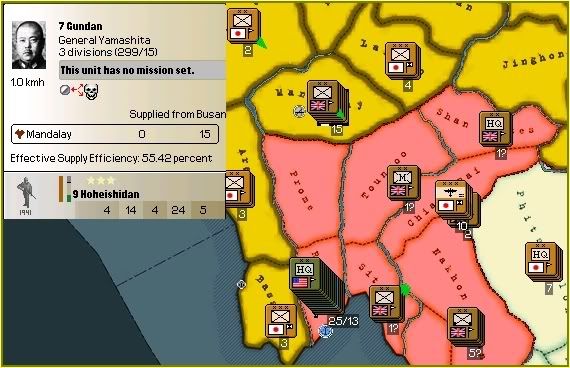
North China Army Headquarters. Jinghong, China.
General Ueda had advanced in northern India and captured Lucknow province. He turned his attention north.

At dawn he would order his tiring troops to attack Nepal in order to try and conquer the small mountainous Country.
0100 March 13th 1945.
North Mariana Trench.
The French fleet had entered the North Mariana Trench showing signs of damage after their almost constant attack during their voyage.

The Siamese bombers operating from Japan had managed to inflict significant damage to the Battleship Lorraine and some damage to the Carrier Bearn. The fleet would immediately turn around and leave the area before Ozawa could find it and inflict more damage.
0700 March 13th 1945.
North China Army Headquarters. Jinghong, China.
Things did not always go according to plan which was nothing new to Higashikuni. The attack on Nepal was not going well.

Ueda would be forced to call off his attack as his troops began to tire in their attempt to remove the single defending Nepalese division that was well dug in to the snow covered mountains. He would try again in a few days once his forces had rested and been reinforced by the single division due shortly.

At 0000 hours on March 14th Higashikuni completed his move forwards and now had his headquarters in Lashio province.
2300 March 14th 1945.
The Skies Above the Sape Strait.
Australian Naval bombers had been harassing Japanese convoys in and around Indonesia for several days and the local interceptors on naval patrol had been ordered to hunt them down.

Mj. General Watanabe found them over the Sape Strait and his two squadrons convinced the single Australian squadron to cease its operations for the time being.
1200 March 15th 1945.
North China Army Headquarters. Lashio, Burma.
British troops had begun to try and reinforce Chiang Rai in Siam in an attempt to prevent Japanese forces taking the province.

They were welcomed by ten squadrons of aircraft carrying out bombing missions in the area. There were no Japanese troops advancing on the province at this time and the bombers would be given time to reduce enemy troop concentrations in the area.

Another British division had been forced to retreat from Mandalay as Higashikuni's troops continued their march on the province. They were due to arrive in just over twelve hours. Only a single squadron looked to be left behind on the airfield and that would also leave before the troops could arrive.
0500 March 16th 1945.
BB Division 1 Flagship. IJN Yamashiro, Gulf of Martapan.
The French fleet was still being followed as it headed west away from the Mariana Trench.

Course and speed had it heading south of its original northerly track but it was still going to head south to the west of Indonesia.
1400 March 16th 1945.
North China Army Headquarters. Lashio, Burma.
Japanese troops had managed to complete some long marches through the hostile terrain of northern and central Burma.

Troops led by General Yamashita had entered Mandalay leaving the Allies with only one air base in the region in Rangoon. Follow up forces had also reinforced Lashio province to prevent a reversal in this area. Most of the forces defending Rangoon appeared to be American.
Nice update! Good Job on securing Mandalay.
Manalay always reminds me of a film company.
Manalay always reminds me of a film company.
The first major land battle between the IJA ant the US Army draws closer. I can barely wait to see what troops the US has stationed in Rangoon.
And it seems that Great Nepal has thwarted your plans for annexation for now. I told you to be careful with such a powerful enemy.
On a lighter note I'm surprised to see how much damage your interceptors seem to have done to the Lorraine. Unless the Lorraine has been visited by the Siamese naval bombers between the two screenshots in the last update.
By the way, I looked up what prefix the French navy uses and it seems that they used none. More interestingly, neither did the German Kriegsmarine use any prefix. So your renaming of the surface ships from KMS to IJN didn't hurt the sailors' feelings since they didn't use the prefix KMS anyway.
The things you learn while writing comments.
And it seems that Great Nepal has thwarted your plans for annexation for now. I told you to be careful with such a powerful enemy.
On a lighter note I'm surprised to see how much damage your interceptors seem to have done to the Lorraine. Unless the Lorraine has been visited by the Siamese naval bombers between the two screenshots in the last update.
By the way, I looked up what prefix the French navy uses and it seems that they used none. More interestingly, neither did the German Kriegsmarine use any prefix. So your renaming of the surface ships from KMS to IJN didn't hurt the sailors' feelings since they didn't use the prefix KMS anyway.
The things you learn while writing comments.
Sokraates said:By the way, I looked up what prefix the French navy uses and it seems that they used none. More interestingly, neither did the German Kriegsmarine use any prefix. So your renaming of the surface ships from KMS to IJN didn't hurt the sailors' feelings since they didn't use the prefix KMS anyway.
The things you learn while writing comments.
Also the IJN didn't use any prefix, so I'm double sure the sailors won't mind.
linky
The Germans did use Prefixes.
Anyways Siam looks to be winding down, which is a good thing. I'm surprised how much damage the French fleet has taken.
As for '44 scenarios, there is always Romania...
Anyways Siam looks to be winding down, which is a good thing. I'm surprised how much damage the French fleet has taken.
As for '44 scenarios, there is always Romania...
What are your long term plans for victory Remmel?
Is there any alternative to world conquest? Isn't the AI for the Allies and Commintern hard coded not to offer peace to the Axis?
Is there any alternative to world conquest? Isn't the AI for the Allies and Commintern hard coded not to offer peace to the Axis?
You could play as Canada, and join the Axis as soon as possible (ideally before Germany falls) and then WC. :rofl:Remble said:I think you can safely say that this will be the last AAR I do on 1944. What else I could do I have no idea
Or perhaps Nepal, they're terrifying!
Deus - Thank you. One airbase to go.
Sokraates, GoforitPanzer - Prefixes were not common amongst a lot of navies during the war, although some did use them as they always have. Whatever is in Rangoon shall die in Rangoon I hope. Lorraine was fairly badly hurt when she left the Mariana Trench after being attacked by the two interceptor squadrons there. She is an older Battleship so gets hurts fairly easily. The World's greater powers can never be taken lightly
Maj. von Mauser - Nearly all of the damage to the French came from the older Siamese bombers and shows how easy they are to damage. Interceptors are not very good at naval attack but even they can make the damage add up over time. Romania with the AI controlling Germany? That is a very scarey position to be in
BlkbrryTheGreat - Neither will allow peace, although the Soviets are still neutral for now. I am not sure I will do a World conquest this time as there is a definate point were it becomes certain victory. Should I manage to destroy the Soviets this will need some consideration, as that is the normal point at which any uncertainty is removed from victory.
Kanil - Canada means I get to attack the U.S. as my first major land conflict which is a bonus if it works
Update to conclude March to follow ...
Sokraates, GoforitPanzer - Prefixes were not common amongst a lot of navies during the war, although some did use them as they always have. Whatever is in Rangoon shall die in Rangoon I hope. Lorraine was fairly badly hurt when she left the Mariana Trench after being attacked by the two interceptor squadrons there. She is an older Battleship so gets hurts fairly easily. The World's greater powers can never be taken lightly
Maj. von Mauser - Nearly all of the damage to the French came from the older Siamese bombers and shows how easy they are to damage. Interceptors are not very good at naval attack but even they can make the damage add up over time. Romania with the AI controlling Germany? That is a very scarey position to be in
BlkbrryTheGreat - Neither will allow peace, although the Soviets are still neutral for now. I am not sure I will do a World conquest this time as there is a definate point were it becomes certain victory. Should I manage to destroy the Soviets this will need some consideration, as that is the normal point at which any uncertainty is removed from victory.
Kanil - Canada means I get to attack the U.S. as my first major land conflict which is a bonus if it works
Update to conclude March to follow ...
Operation Dilemma
18
0000 March 18th 1945.
Industry Offices. Tokyo, Japan.
Minister Ginjiro could still do nothing to increase industrial output for repairs and upgrades but some new production would increase Japan's Armed Forces.
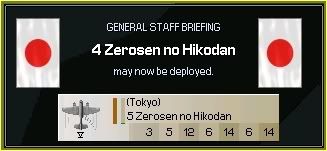
Two Tactical bomber squadrons would join the Imperial Japanese Air Force and head for Indochina to organise themselves, before commencing bombing operations in Siam.
0100 March 19th 1945.
BB Division 1 Flagship. IJN Yamashiro, Gulf of Martapan.
Yamamoto knew that the French fleet was heading back towards Indonesia and gave orders to protect one of his fleets in the area.
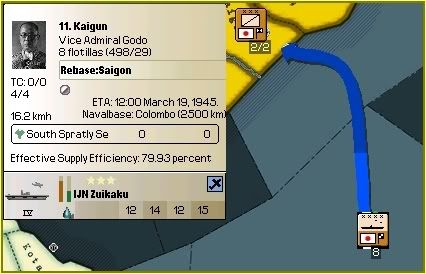
Godo turned his fleet towards Saigon to avoid any possible confrontation with the French.
0300 March 20th 1945.
North China Army Headquarters. Lashio, Burma.
The fluid situation in India shifted once again as attacks began for two provinces. Combat also erupted in southern Siam.
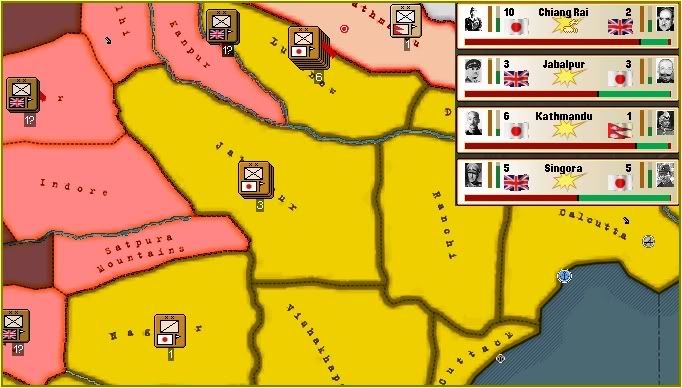
Japanese forces led by General Ueda attacked Nepal again and this time succeeded. The Nepalese division defending the province was captured.
Allied forces attacked the defences of General Kawabe in Jabalpur and forced him to retreat towards Vishakhapatnam.
General Asaka came under attack from Field Marshal Alexander's forces in Singora which would be a more prolonged battle.
Allied forces attacked the defences of General Kawabe in Jabalpur and forced him to retreat towards Vishakhapatnam.
General Asaka came under attack from Field Marshal Alexander's forces in Singora which would be a more prolonged battle.
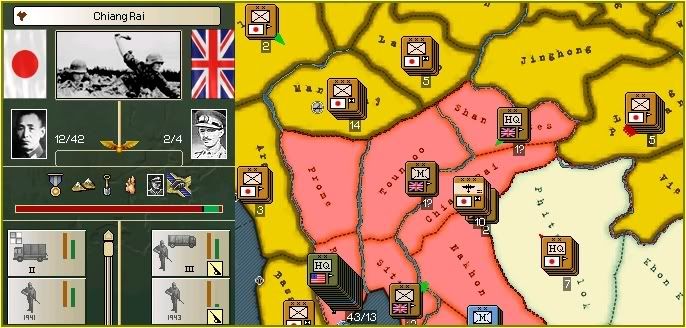
A second British division had entered Chiang Rai and Higashikuni ordered an assault at 0400 hours to remove them both with support from the Imperial Japanese Air Force. This time Field Marshal Hata would order four of his seven divisions to advance into the province.
0800 March 20th 1945.
BB Division 1 Flagship. IJN Yamashiro, Gulf of Martapan.
Two pre-war British Destroyer Flotillas had entered the Gulf of Martapan to test Yamamoto's blockade.
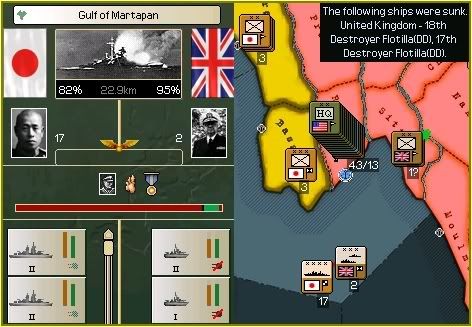
Neither would leave the area alive as the Battleships IJN Hyuga and IJN Yamashiro sank one each.
2200 March 20th 1945.
North China Army Headquarters. Lashio, Burma.
Ground combat was still ongoing in Indochina at 2200 hours on March 20th with casualties beginning to mount.
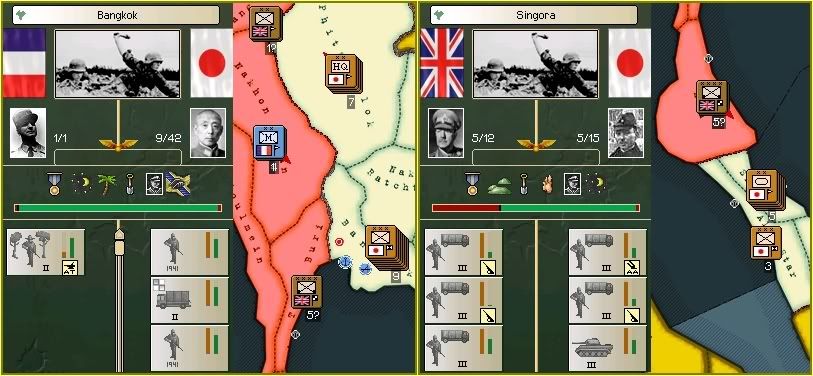
A French militia division was launching multiple suicide attacks across the river towards Bangkok. There was no threat from the attacks and the militia division was just making itself an attractive target for the bombers flying overhead.
The battle for Singora was winding down as Alexander's forces began to suffer increasing casuallties as they tried to remove the very well entrenched Japanese armoured forces. The battle would end at dawn with the British troops withdrawing to lick their wounds.
The battle for Singora was winding down as Alexander's forces began to suffer increasing casuallties as they tried to remove the very well entrenched Japanese armoured forces. The battle would end at dawn with the British troops withdrawing to lick their wounds.
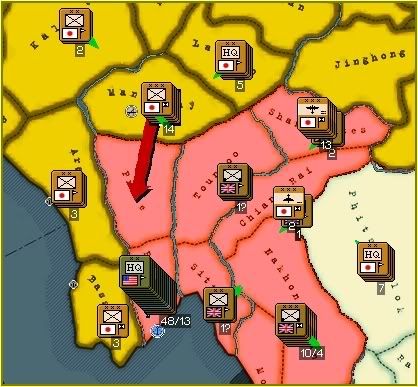
At 0600 on March 21st Higashikuni gave the orders for the main Japanese army in Burma to advance towards the undefended province of Prome. The march would not be a quick one as it never was in this terrain.
0600 March 21st 1945.
BB Division 1 Flagship. IJN Yamashiro, Gulf of Martapan.
More attempts were made to try and run the blockade of Rangoon. BB Division 1 was not going to let anything pass them for the time being.
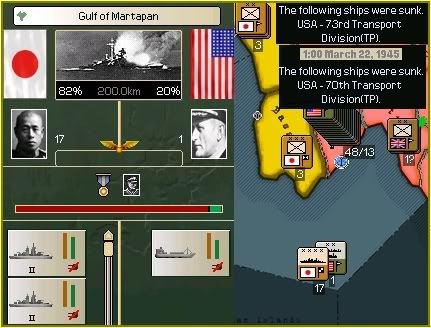
Two seperate interceptions of incoming Transport Divisions resulted in two more lost fleets for the Americans. IJN Yamashiro would sink both.
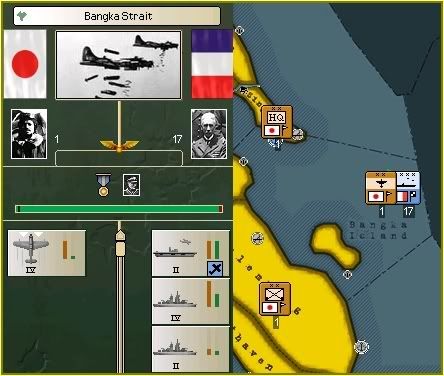
The French fleet was spotted again, at 0000 hours March 23rd, in the Bangka Strait as it headed north through the Malacca Strait.
0000 March 24th 1945.
Intelligence Offices. Tokyo, Japan.
Research projects were not something that occured on a daily basis but one was completed with the aid of blueprints from Japan's former German ally.

Nakajima had completed their project to provide a Basic Rocket Interceptor and were tasked to improve on the design by Kuniaki.
0100 March 24th 1945.
North China Army Headquarters. Lashio, Burma.
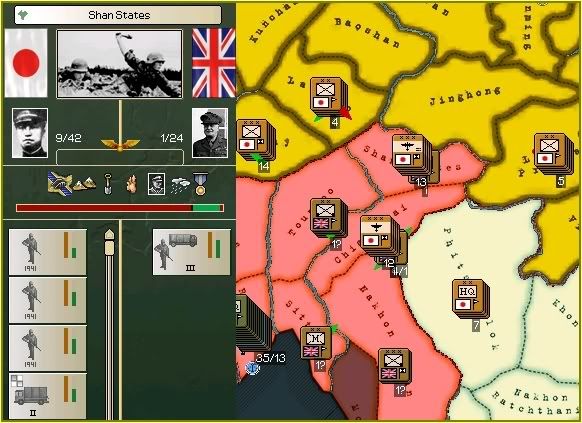

1000 March 24th 1945.
BB Division 1 Flagship. IJN Yamashiro, Gulf of Martapan.
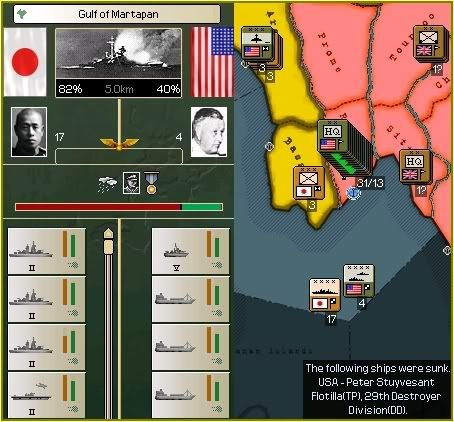
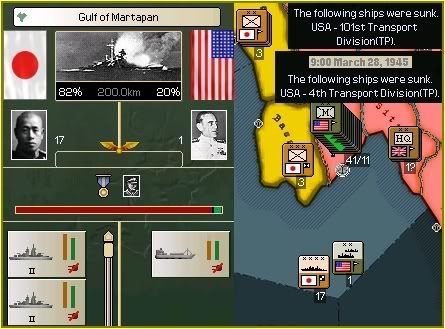
0700 March 26th 1945.
North China Army Headquarters. Lashio, Burma.
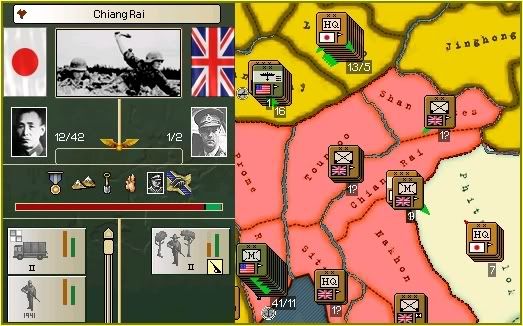
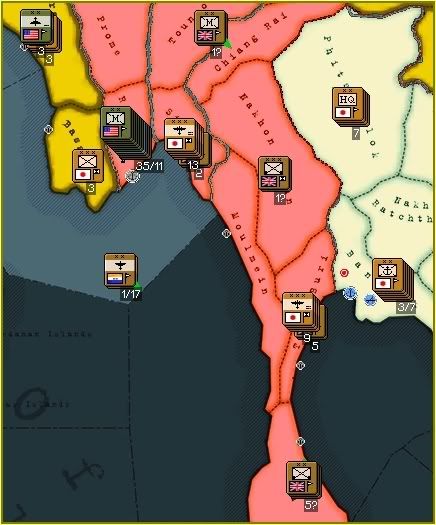
0400 March 29th 1945.
Imperial Japanese Air Force offices. Tokyo, Japan.
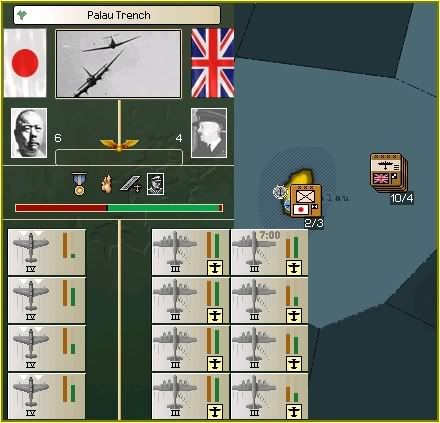
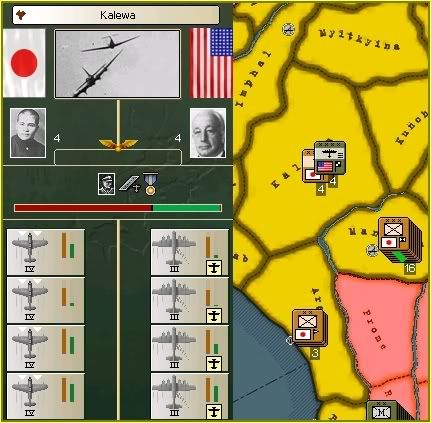
0800 March 30th 1945.
BB Division 1 Flagship. IJN Yamashiro, Gulf of Martapan.

2330 March 30th 1945.
Diplomatic Offices. Tokyo, Japan.
North China Army Headquarters. Lashio, Burma.
Another attack was ordered by Higashikuni to shrink the enemy held territory in Burma.

The single division was easily brushed aside by the superior forces advancing upon the province, led by Higashikuni himself, with a large amount of air support. Higashikuni would advance into the province.

At 1000 hours, as dusk settled across the region, South African interceptors engaged the Japanese bomber force operating across Siam above Phitsanulok province. Damage was fairly minor, as it was spread across the much larger Japanese force, but several squadrons would be grounded for a few days as a result. The South African aircraft would also suffer enough damage to force them to recover from the combat. Japanese aircraft could recover faster as they were operating from a much less crowded airbase. The latest report from Rangoon showed thirty five Allied squadrons trying to use its facilities.
1000 March 24th 1945.
BB Division 1 Flagship. IJN Yamashiro, Gulf of Martapan.
The American Merchant marine had not completely exhausted its resources as more ships tried to embark troops from Rangoon. It was becoming clear that the Allies were trying to evacuate forces from Burma. Yamamoto was not going to let that happen even though it made the job of conquering the region harder. Should these troops escape from Burma they would merely show up somewhere else and it was far better to remove their threat when it suited Japan.

The 29th Destroyer Division would provide some protection until it was sunk by the Battleship IJN Hyuga. IJN Yamashiro would sink the Peter Stuyvesant Flotilla but two Transport Divisions would escape this encounter.

The two remaining Transport Divisions would try again over the next two days and both would fall to IJN Yamashiro.
0700 March 26th 1945.
North China Army Headquarters. Lashio, Burma.
The fifth and final British division from Sittang arrived in Chiang Rai and was attacked immediately by the advancing Japanese forces.

The militia division had already been damaged by air attacks and stood no chance of halting the progress of Higashikuni's troops.

By 0100 March 28th the bombers had reduced the enemy forces in Siam and Burma and continued their mission to rid the area of all enemy troops.
0400 March 29th 1945.
Imperial Japanese Air Force offices. Tokyo, Japan.
Chief of the Air Force Jun had dispersed his interceptor forces over a wide area to protect both Japanese forces and shipping lanes from enemy activity. They would encounter increased enemy bomber activity throughout March 29th.

Another major air battle occured over the Palau Trench as the massed attack strategy was tested again, this time by British Strategic bombers. The six interceptor squadrons were enough to inflict higher casualties amongst the bombers.

Fukui's interceptor wing encountered an American Strategic bomber wing over Kalewa in northern Burma. The bombers were already damaged from previous encounters, probably over the Mariana Trench, and during a rare equal dogfight the Japanese interceptors had the better of the engagement.
0800 March 30th 1945.
BB Division 1 Flagship. IJN Yamashiro, Gulf of Martapan.
The attempts to extract American forces in Burma continued as March drew to a close. Yamamoto's fleet was ready as always.

IJN Yamashiro would sink both of the latest Transport Divisions that tried to run the blockade. The remnants of the British Battlefleet that had been hiding in Rangoon had managed to slip away un-noticed during one of the frequent squalls that ran through the area, much to Yamamoto's annoyance.
2330 March 30th 1945.
Diplomatic Offices. Tokyo, Japan.
Foreign Minister Mamoru was gathering his documents for the monthly breifing that was due to begin shortly when his aid knocked on his door.
"There is a Foreign Ambassador here to see you Minister Mamoru." the aid informed Mamoru.
Mamoru did not have the time to see the diplomat as he was in a hurry to reach the Imperial Palace but he had little choice in the matter. "Show him in please." he replied to his aid.
"Good morning Ambassador." Mamoru greeted the diplomat.
"If you say so Minister Mamoru." he replied.
Alarms began to ring in Mamoru's head immediately as the Ambassador in question was usually cordial even though relations between Japan and his Country were not particularly good.
"I take it that this is not a social visit Ambassador?" Mamoru asked.
"You would be correct." the Ambassador replied. "It is with the utmost regret that I have to inform you that my Nation is hereby in a state of War with Japan. Your expansionist ways can no longer be tolorated by my Government."
"I see." Mamoru replied keeping his diplomatic poise, even though his brain was working overtime to try and figure out some way to avert this disaster. "I trust there is no way that I can change your mind on this?" he asked.
"No there is not. We have obligations to certain other Countries with which Japan is at War and we have to honour our debt to them."
Honour was something Mamoru could completely understand. "I will inform the Cabinet of your decision Ambassador."
"Thank you Minister Mamoru." the Ambassador replied as he walked out of the Foreign Minister of Japan's office.
Looking at the time Mamoru realised that this news would have to wait until the meeting. The Emperor and Cabinet would not be best pleased to know that a very large threat had just appeared on the horizon. He finished gathering his documents and hurried towards the Imperial Palace before he was inappropriately late.
"There is a Foreign Ambassador here to see you Minister Mamoru." the aid informed Mamoru.
Mamoru did not have the time to see the diplomat as he was in a hurry to reach the Imperial Palace but he had little choice in the matter. "Show him in please." he replied to his aid.
"Good morning Ambassador." Mamoru greeted the diplomat.
"If you say so Minister Mamoru." he replied.
Alarms began to ring in Mamoru's head immediately as the Ambassador in question was usually cordial even though relations between Japan and his Country were not particularly good.
"I take it that this is not a social visit Ambassador?" Mamoru asked.
"You would be correct." the Ambassador replied. "It is with the utmost regret that I have to inform you that my Nation is hereby in a state of War with Japan. Your expansionist ways can no longer be tolorated by my Government."
"I see." Mamoru replied keeping his diplomatic poise, even though his brain was working overtime to try and figure out some way to avert this disaster. "I trust there is no way that I can change your mind on this?" he asked.
"No there is not. We have obligations to certain other Countries with which Japan is at War and we have to honour our debt to them."
Honour was something Mamoru could completely understand. "I will inform the Cabinet of your decision Ambassador."
"Thank you Minister Mamoru." the Ambassador replied as he walked out of the Foreign Minister of Japan's office.
Looking at the time Mamoru realised that this news would have to wait until the meeting. The Emperor and Cabinet would not be best pleased to know that a very large threat had just appeared on the horizon. He finished gathering his documents and hurried towards the Imperial Palace before he was inappropriately late.
OH SHIT! soviet union declared war  (i´m sure they had...
(i´m sure they had...  ) now this is getting more and more interesting...
) now this is getting more and more interesting... 
the only thing left is a massive amphibious assault from the allies in southern china... :rofl:
the only thing left is a massive amphibious assault from the allies in southern china... :rofl:
I hope Nepal surrenders soon, Remble. It would be quite embarrassing to the Japanese if they can't knock out a small, one-provice country defended by one division (regardless of how well dug-in it is).
Hmm...desperate Allied soldiers launching suicide attacks against Japanese forces? Has the world turned upside down? :wacko:
Oh, yeah. Something about some country declaring war on Japan. I guess they won't be getting any New Years greeting cards from now on.
I thought Japan was already at war with Panama.
Remble said:A French militia division was launching multiple suicide attacks across the river towards Bangkok. There was no threat from the attacks and the militia division was just making itself an attractive target for the bombers flying overhead.
Hmm...desperate Allied soldiers launching suicide attacks against Japanese forces? Has the world turned upside down? :wacko:
Oh, yeah. Something about some country declaring war on Japan. I guess they won't be getting any New Years greeting cards from now on.
trekaddict said:Its either the SU or the second biggest enemy of Japan: Panama!
I thought Japan was already at war with Panama.


